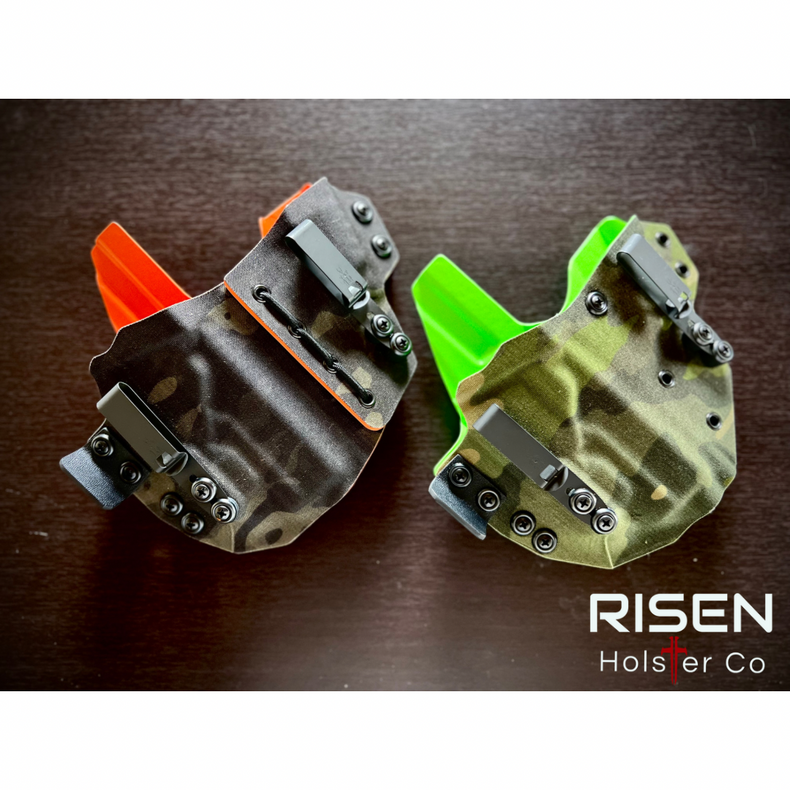Carrying a concealed firearm is a significant responsibility that requires careful consideration of safety, comfort, and practicality. As someone who carries daily, I understand the challenges and decisions that go into choosing the right method. If you’re new to conceal carry, this guide will walk you through the different ways to carry and help you decide what might work best for you.
Choosing the right method for concealed carry is crucial for ensuring both safety and practicality. The method you select will impact your comfort, accessibility, and ability to respond effectively in an emergency.
Appendix Carry
What it is: Appendix carry places the firearm at the front of your body, near your waistband, typically around the 1 o’clock position.
Benefits:
- Accessibility: The firearm is easy to reach with your dominant hand.
- Concealability: Proper positioning and a quality holster can make appendix carry very discreet.
- Quick Draw: The position allows for a fast and efficient draw.
Drawbacks:
- Comfort: Sitting for long periods can be uncomfortable, especially if you’re wearing a larger firearm.
- Risk Awareness: The position requires extra caution with trigger discipline and reholstering to avoid accidents.
Who it’s best for: Those who prioritize quick access and are willing to invest in a well-fitted holster for added safety and comfort.
Note: Body type can significantly influence the comfort and practicality of appendix carry. Individuals with different builds may experience varying levels of ease or difficulty with this method. To see our Appendix carry options, click here.
On the Hip (3-4 O’Clock Position)
What it is: Carrying on the hip places the firearm on your dominant side, around the 3 to 4 o’clock position.
Benefits:
- Natural Fit: This position feels intuitive for many people.
- Comfort: It’s more comfortable for extended wear, especially when sitting.
- Versatility: Works well for various firearm sizes.
Drawbacks:
- Concealability: Larger firearms can print (show through clothing), especially with tighter outfits.
- Draw Speed: Slightly slower than appendix carry.
Who it’s best for: Beginners who want a comfortable, accessible, and versatile carry method.
This position is particularly suitable for activities involving prolonged sitting, such as driving or office work, as it allows for greater comfort without compromising accessibility. To check out our holsters for hip carry, click here.
Outside the Waistband (OWB)
What it is: OWB carry places the holster on the outside of your waistband, typically on the hip or slightly behind it.
Benefits:
- Comfort: This is one of the most comfortable carry methods, as the firearm isn’t pressed against your body.
- Ease of Draw: The firearm is easily accessible and quick to draw.
Drawbacks:
- Concealability: OWB requires more effort to conceal and may need larger or layered clothing to stay hidden.
- Bulk: The holster and firearm are more noticeable than other methods.
Who it’s best for: Those who prioritize comfort over deep concealment, especially in colder weather when layering clothing. To check out our OWB holsters for concealed carry, click here.
Everyday Carry (EDC) Bag
What it is: Carrying in an EDC bag means storing your firearm in a designated compartment of a specially designed backpack, purse, or sling bag.
Benefits:
- Convenience: Ideal for people who can’t or prefer not to carry on their body.
- Flexibility: Works well for larger firearms and additional gear like spare magazines or medical kits.
- Concealability: The firearm is completely hidden from view.
Drawbacks:
- Access Speed: Drawing from a bag is significantly slower than on-body carry.
- Security: There’s a risk of the bag being misplaced or stolen.
- Training Required: Drawing from a bag requires regular practice to ensure you’re prepared in an emergency.
Who it’s best for: Those who need to carry off-body due to lifestyle or wardrobe constraints, and who are disciplined about keeping the bag secure and accessible. Due to increased popularity, EDC bags come in many shapes and sizes. Companies like Viktos.com and Vertx.com offer several great options.
Choosing Your Method
When starting your concealed carry journey, consider these factors:
- Comfort: You’ll be wearing your setup for hours, so comfort is essential.
- Concealability: Choose a method that suits your typical clothing style and environment.
- Accessibility: Ensure you can draw quickly and efficiently if needed.
- Safety: Always use a high-quality holster that fully covers the trigger guard and practice regularly with your chosen method.
Final Thoughts
Concealed carry is a personal decision, and there’s no one-size-fits-all solution. Experiment with different methods to find what works best for your body type, lifestyle, and daily routine. Remember, carrying a firearm is about being prepared, not just armed. Take the time to train, practice situational awareness, and prioritize safety above all else.
If you’re looking for holsters to support your concealed carry journey, check out our selection of high-quality custom and quick-ship Kydex holsters at Risen Holster Co. We’re here to help you carry with confidence!

